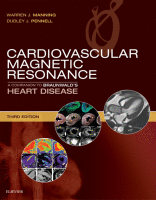Physical Address
304 North Cardinal St.
Dorchester Center, MA 02124

A coronary stenosis may be observed during cardiovascular magnetic resonance (CMR) as an area of signal loss caused by turbulent flow, and although both the degree and the extent of signal loss are indicative of the severity of the stenosis,…

Chapter 23 reviewed the technical issues and solutions for coronary artery cardiovascular magnetic resonance (CMR) imaging. This chapter reviews the clinical data comparing coronary artery CMR with invasive x-ray coronary angiography for identification of anomalous coronary artery disease (CAD), characterization…

Despite significant efforts in prevention and treatment, coronary artery disease (CAD) remains the leading cause of death in the United States, accounting for one in every seven deaths. Each year nearly 700,000 Americans are estimated to have a new myocardial…

Left ventricular (LV) diastolic function has been recognized as an important factor in the pathophysiology of many common cardiovascular diseases. Dilated and hypertrophic cardiomyopathy (HCM), coronary artery disease (CAD), and systemic hypertension are all associated with abnormal LV filling dynamics.…

The detection of residual myocardial viability in a patient with regional or global severe left ventricular (LV) dysfunction is of clinical importance to plan the therapeutic strategy because revascularization of dysfunctional but viable myocardium may improve LV function. Several imaging…

Approximately 550,000 Americans will suffer an acute myocardial infarction (AMI) each year. Despite major advances in AMI therapies, mortality and incident heart failure (HF) remain significant problems. Five-year mortality is estimated at 36% in men and 47% in women. The…

Cardiovascular magnetic resonance (CMR) can characterize acute myocardial infarction (AMI) in unique ways and with high quality. Cine CMR can assess left ventricular (LV) volumes, ejection fraction (LVEF), and regional wall motion in ways comparable to a high-quality transthoracic echocardiogram.…

Considerable progress in myocardial perfusion cardiovascular magnetic resonance (CMR) has been achieved recently and its diagnostic performance has been documented in single-center and multicenter trials. From single-center trials, and particularly from multicenter trials, the knowledge of how to perform and…

Master and Oppenheimer described the first stress test in 1929. Several methods of assessing myocardial ischemia have subsequently been developed, including those that incorporate electrocardiograms (ECGs), echocardiography, myocardial scintigraphy, and, most recently, cardiovascular magnetic resonance (CMR). Since 1987, stress CMR…

The accurate and reproducible assessment of cardiac function is a fundamental aim of noninvasive cardiac imaging. It forms the foundation upon which much of the assessment and management of myocardial dysfunction, ischemia, viability, remodeling, valvular, and other cardiac disorders are…